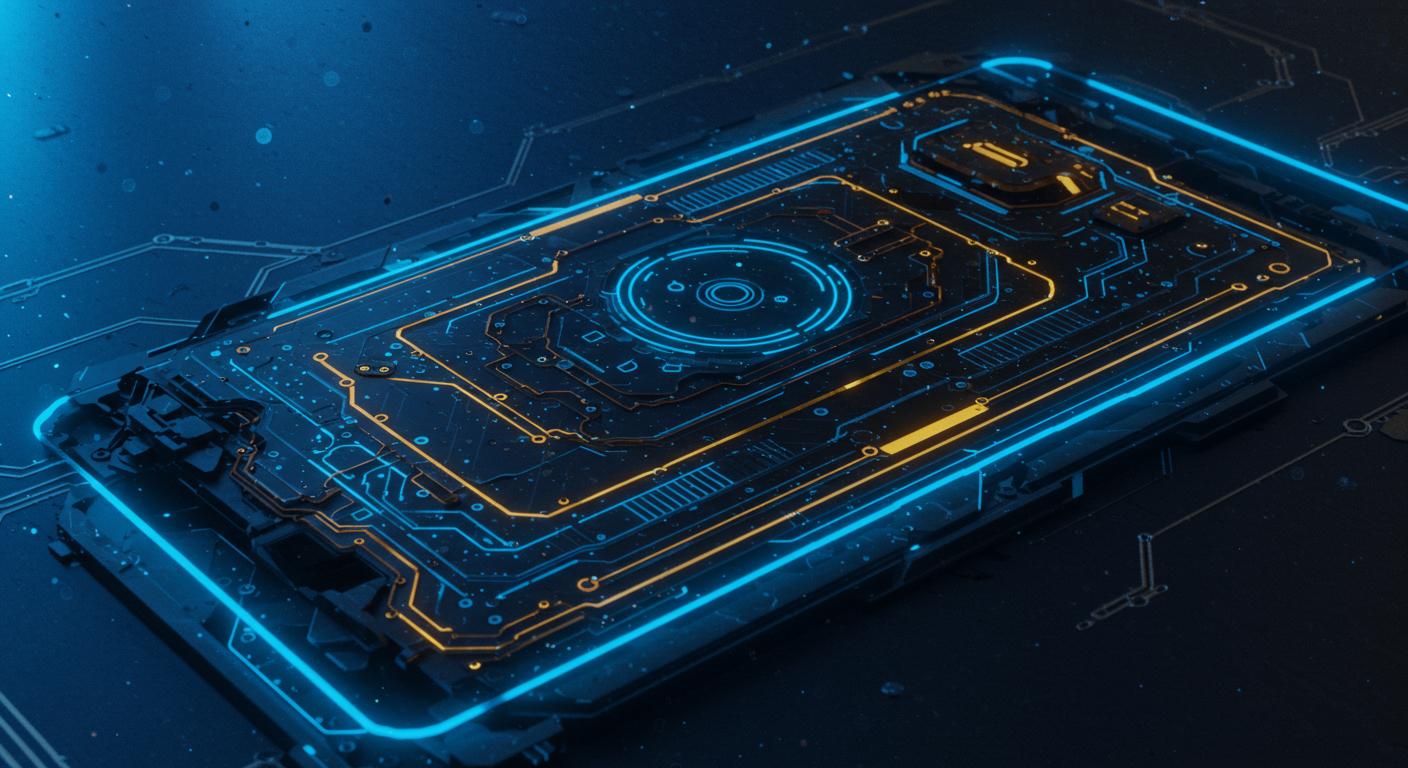AI-Powered Design: How Figma is Revolutionizing Digital Creation

Figma is no longer just a design tool; it's poised to become a canvas where artificial intelligence understands and anticipates a designer's very thoughts.
Figma's Reign in Design
Figma has revolutionized the design world with its collaborative, cloud-based platform, quickly becoming a favorite among graphic designers and product managers. Now, with AI integration, it's on the verge of an even bigger transformation.The AI Revolution's Significance
The integration of AI into design platforms like Figma signals a seismic shift in how digital products are created. Imagine AI handling repetitive tasks, suggesting design improvements, and even generating entire layouts based on simple prompts. As discussed in our AI Fundamentals guide, this isn't just about automation; it's about unlocking new levels of creativity.Redefining Workflows & Creativity
AI-powered features will redefine design workflows, allowing designers to focus on higher-level strategic thinking and creative problem-solving.- Streamlined Tasks: AI can automate tedious tasks like resizing elements, generating variations, and ensuring design consistency.
- Intelligent Suggestions: AI can analyze designs and suggest improvements based on best practices, accessibility guidelines, and user behavior data.
- Generative Design: Imagine simply describing your design goals and having AI generate multiple layout options to choose from.
Coming Soon to Figma
While specific features are under wraps, expect to see AI-powered tools that streamline workflows, enhance creativity, and ultimately empower designers to achieve more, faster. Stay tuned for our in-depth reviews as these exciting tools hit the market, and discover the Top AI Tools in 2025 that will boost your productivity.The future of Figma is intelligent, intuitive, and incredibly exciting!
Figma, the darling of digital design, is no longer just a collaborative canvas; it's rapidly becoming an AI-powered design powerhouse.
Unveiling the AI-Powered Features Transforming Figma

Figma's embracing of AI is transforming workflows, offering designers new levels of efficiency and creative freedom. Let's dive into some key areas:
- AI-Powered Auto Layout: Imagine effortlessly arranging elements with intelligent spacing and resizing. Figma’s enhanced Auto Layout uses AI to predict the optimal layout based on content and design principles. This frees up designers from tedious manual adjustments.
- Intelligent Component Suggestions: Ever struggled to find the right component for a specific design task? AI is now helping Product Managers by suggesting relevant components based on the context of your design, streamlining workflows and maintaining design system consistency.
- Generative Fill: Need to quickly generate realistic or abstract visuals? Figma's integrating generative fill capabilities, similar to Adobe Firefly, allowing designers to create textures, patterns, and even entire scenes using simple text prompts. This democratizes advanced visual creation and speeds up prototyping.
- AI Assistance for Design Consistency & Accessibility: AI not only boosts creativity, it ensures quality. Features are emerging that automatically check designs for consistency with established style guides. Furthermore, integrated accessibility checks flag potential issues for users with disabilities, making digital design more inclusive.
- User Flow Optimization: Understanding how users will interact with a design is crucial. AI is beginning to provide insights into user flow optimization, predicting potential usability bottlenecks and suggesting improvements to the user experience. This creates smoother, more intuitive products.
Ethical Considerations in the AI Design Revolution
As AI assumes a larger role, AI ethics in design become crucial. We must address potential biases in AI-generated content and ensure fairness and inclusivity. The future of design hinges on responsible innovation.
In summary, Figma's AI integration is revolutionizing digital creation, automating tasks, boosting creativity, and ensuring quality. As AI continues to evolve, designers who embrace these changes will be best positioned to shape the future of digital experiences. Next up, we’ll explore how AI Writing Tools are changing the world of marketing.
Alright, let's dive into how AI is reshaping the design landscape, specifically within Figma – it's like giving designers superpowers, really.
Supercharging Your Workflow: Practical Applications of AI in Figma
It's no longer a question of if AI will impact design, but how. And with Figma, that "how" is becoming increasingly clear, offering tangible benefits to designers at every level. Let's explore some real-world examples, shall we?
Generating Design Variations
"Creativity is intelligence having fun." – I think I said that once. Maybe.
One of the most immediate applications is AI-powered design variation. Imagine you've created a button. Now, use AI to instantly generate dozens of variations in color, shape, and text! You can then use Design AI Tools and see what resonates best with your users. It's A/B testing on steroids, and eliminates the tedious, repetitive stuff.
Personalized User Interfaces
AI can also analyze user data to create personalized UI experiences. Tools like Uizard, the AI design assistant, can help predict user preferences and suggest layouts and content that are more likely to engage specific user segments. This isn't just about aesthetics; it's about optimizing the user journey.
Simplifying Complex Design Systems
Managing a large design system can feel like herding cats. AI can automate many of the tasks associated with this. It can, for example, identify inconsistencies in your component library, suggest improvements, and even automatically update styles across your entire design file. You can use AI to maintain Productivity Collaboration and ensure visual consistency.
Accessibility Compliance and Collaboration
- Figma AI Accessibility: AI can analyze designs for accessibility issues like color contrast, font sizes, and alternative text for images. Addressing these issues early drastically improves user experience, and minimizes legal risks.
- AI Collaboration Figma: Tools can streamline feedback loops by summarizing comments, identifying key issues, and even generating automated responses to common questions. It's like having an AI project manager keeping everyone on the same page.
AI is rapidly reshaping design, making it more efficient and accessible than ever before.
Unleashing AI in Figma: A Designer's Playground
Figma, already a powerhouse for collaborative design, becomes a hyper-productive environment with the right AI plugins and integrations. Let's explore some game-changers:
- Image Upscaling: Tools like Icons8 Smart Upscaler use AI to enhance low-resolution images directly within Figma, saving you the hassle of external editing. It's beneficial for projects where source images are less than ideal.
- Text Generation: Need compelling copy for your designs? AI-powered text generators such as CopyAI can craft headlines, body text, and even microcopy tailored to your project's needs. Forget writer's block!
- Code Conversion: Transform your designs into functional code using plugins that leverage AI. These tools translate design elements into HTML, CSS, or Javascript, streamlining the handoff to developers.
Choosing the Right AI Companion

Selecting the ideal AI plugin depends heavily on your specific needs:
| Task | Plugin Recommendation | Pros | Cons |
|---|---|---|---|
| Image Enhancement | VanceAI | Excellent detail recovery, batch processing | Can be pricey for high-volume use |
| Content Creation | Jasper | Versatile, generates various content types, integrates well with Figma | Subscription-based; output may require editing for brand consistency |
| Code Generation | Teleporthq | User-friendly interface, supports multiple frameworks | May require fine-tuning for complex designs |
Navigating the Integration Landscape
While AI integrations are powerful, remember these best practices:
- Security First: Prioritize plugins from reputable sources. Always review permissions and data usage policies to maintain Figma plugin security.
- Human Oversight: AI is a tool, not a replacement. Always review and refine AI-generated content to ensure accuracy and alignment with your design vision.
As AI evolves, expect even more seamless and intuitive design experiences within Figma. Embracing these technologies will undoubtedly separate the designers of tomorrow from yesterday. Stay tuned for more insights!
Figma's AI-powered features are rapidly reshaping the landscape of digital design, but how does it stack up against the competition?
AI Capabilities: Figma vs. The Field
While many design platforms are incorporating AI, Figma's approach is particularly notable. Let's consider a few contenders:- Adobe XD: Adobe has integrated AI features like Adobe Sensei, but Figma’s real-time collaboration and web-first architecture give it an edge in accessibility and iterative design.
- Sketch: While Sketch remains a popular choice, its reliance on plugins for AI functionality can lead to fragmentation and inconsistent user experiences compared to Figma’s natively integrated AI tools.
- Figma: Tools like the soon-to-be released Magician for Figma (not on our index) and the AI photo editor are deeply integrated into its core workflow, streamlining tasks like image upscaling and content generation, enhancing overall design efficiency.
Strengths and Weaknesses: Figma's AI Implementation
Figma's biggest strength lies in its collaborative nature; integrating AI into this environment allows teams to ideate and refine designs in real-time, with AI providing intelligent assistance.Imagine brainstorming layout options, and Figma's AI suggests alternatives based on UI/UX best practices as you design.
However, reliance on cloud connectivity can be a weakness in areas with limited internet access. Also, Figma could strengthen its AI offerings in areas like advanced animation assistance. Want to learn more about AI fundamentals? Check out our AI Fundamentals Guide.
Figma's AI-First Trajectory
Figma's AI-first approach – combined with its already dominant collaborative features – positions it as a frontrunner in the design platform race. By continually enhancing its AI capabilities, Figma not only attracts new users but also solidifies its position with existing ones, creating a powerful network effect. Check out these Design AI Tools to learn more.Community & Tool Adoption
The vibrant Figma community AI plays a significant role in driving adoption. Community-created plugins and shared resources amplify Figma's capabilities, allowing for rapid experimentation and problem-solving within the design ecosystem.In conclusion, Figma's AI-driven advancements are not just incremental improvements; they represent a fundamental shift in how design is approached, making it a formidable force in the industry. Speaking of future trends, let's discuss AI's impact on creativity.
The design world stands on the cusp of an unprecedented transformation, all thanks to the rapid evolution of AI.
Personalized Design Experiences
Imagine a Figma interface that adapts to your individual style, skill level, and project needs – that’s the promise of personalized design experiences powered by AI.
- Adaptive UIs: AI can learn your preferred tools and workflows, customizing the interface to maximize efficiency.
- Intelligent Suggestions: Receive real-time recommendations for color palettes, typography, and layout options based on AI analysis of current design trends and best practices. For inspiration, tools like Adobe Firefly will play a role. This generative AI tool enables users to create astonishing new content from text prompts.
- Context-Aware Assistance: AI assistants within Figma anticipate your next move, providing relevant tutorials, resources, and automation options exactly when you need them.
Automated Prototyping and AI-Driven Education
Prototyping can be time-consuming. AI can accelerate this process, even for non-designers.
- AI-Powered Animation: Quickly create interactive prototypes with realistic animations generated automatically based on design elements and user flows.
- Smart Component Generation: Generate ready-to-use UI components – buttons, forms, navigation menus – based on design system guidelines, saving hours of manual creation.
- Personalized Tutorials: AI tutors offer customized design education within Figma, guiding users through specific features, techniques, and best practices tailored to their skill gaps.
Democratization of Design
AI lowers the barrier to entry, empowering non-designers and fostering creativity across disciplines. Want to learn more? Check out AI Fundamentals.
"The most profound technologies are those that disappear. They weave themselves into the fabric of everyday life until they are indistinguishable from it." – Mark Weiser, The Computer for the 21st Century
AI has the potential to make design tools accessible to everyone.
- AI-Assisted Templates: Non-designers can create professional-looking designs by simply customizing AI-generated templates, eliminating the need for extensive design knowledge.
- Voice-Controlled Design: Design interfaces using natural language commands, making the creation process intuitive and accessible to individuals with varying levels of technical expertise.
Figma's transformation into an AI-powered design hub is no longer a futuristic dream, but a tangible reality shaping digital creation.
Embarking on Your AI-Figma Journey
For designers eager to integrate AI into their Figma workflow, a structured approach is key:- Start with the Fundamentals: Familiarize yourself with basic AI concepts. AI Fundamentals offers a solid starting point, demystifying the tech without the jargon.
- Explore AI Plugins in Figma: Delve into the Figma plugin ecosystem. Experiment with tools like Magician for Figma, designed to streamline design tasks through AI.
- Leverage AI Design Principles: Look into resources offering guidance on AI design. Discover new methods for AI design by learning AI in Practice.
Navigating the Learning Curve
"The only constant is change," - Heraclitus, probably rewritten by an AI.
Keep up by finding learning resources:
- Official Figma Resources: Figma provides tutorials and documentation on integrating AI features. These official guides offer the most accurate, up-to-date information.
- AI Design Communities: Connect with fellow designers in AI design communities to share insights, best practices, and innovative use cases. Seek input from the Design AI Tools category.
- Experiment Responsibly: Always back up your work and experiment with AI features in a non-critical environment first, that way there will be no production errors.
Troubleshooting Common AI Issues
Encountering glitches is part of the process. Some "Figma AI troubleshooting" tips:
- Plugin Compatibility: If a plugin crashes, ensure it's compatible with your Figma version. Check for updates or contact the plugin developer.
- AI Feature Limitations: Recognize that AI has limitations. Prompt engineering, explained at Prompt Engineering, is crucial for AI.
- Resource Constraints: Large AI processes can be resource-intensive. Close unnecessary applications and increase Figma's memory allocation if possible.
Keywords
Figma AI, AI in Figma, Figma AI features, AI powered design, Generative AI design Figma, Figma design tools AI, AI design software, Figma plugins AI, AI for UI/UX design, Intelligent design Figma, Figma machine learning, Future of Figma, AI design workflow
Hashtags
#FigmaAI #AIDesign #DesignTech #FutureOfDesign #DigitalDesign
Recommended AI tools
ChatGPT
Conversational AI
AI research, productivity, and conversation—smarter thinking, deeper insights.
Sora
Video Generation
Create stunning, realistic videos and audio from text, images, or video—remix and collaborate with Sora, OpenAI’s advanced generative video app.
Google Gemini
Conversational AI
Your everyday Google AI assistant for creativity, research, and productivity
Perplexity
Search & Discovery
Clear answers from reliable sources, powered by AI.
DeepSeek
Conversational AI
Efficient open-weight AI models for advanced reasoning and research
Freepik AI Image Generator
Image Generation
Generate on-brand AI images from text, sketches, or photos—fast, realistic, and ready for commercial use.
About the Author

Written by
Dr. William Bobos
Dr. William Bobos (known as 'Dr. Bob') is a long-time AI expert focused on practical evaluations of AI tools and frameworks. He frequently tests new releases, reads academic papers, and tracks industry news to translate breakthroughs into real-world use. At Best AI Tools, he curates clear, actionable insights for builders, researchers, and decision-makers.
More from Dr.

